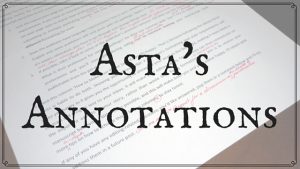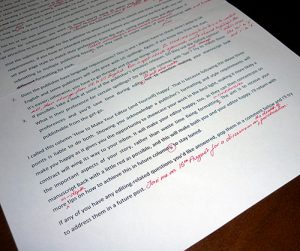 Greetings! My name is Asta, and welcome to my new column Asta’s Annotations.
Greetings! My name is Asta, and welcome to my new column Asta’s Annotations.
Since this is my first time posting, allow me to introduce my column and myself. I am a published author of both mainstream (Nicki J. Markus) and LGBT (Asta Idonea) fiction. I am also a qualified freelance editor, working mainly on LGBT manuscripts. I’ll be posting a monthly column at Queer Sci-Fi in which I’ll cover a range of topics. However, my primary focus will be on tips and tricks for writers and style discussions. Wearing my editor hat, I’ll also offer some advice on preparing your manuscript/submission, and that’s where I thought I’d start today. All my posts will draw on my personal experience. It may be that my tips won’t suit everyone, but even if they aren’t for you, I hope they’ll offer a springboard to help you find your personal style and preference. So, without further ado….
Everybody has his or her own preference with regards to font style and size. Nevertheless, when it comes to preparing stories for submission, you want to ensure you’re doing all within your power to make your manuscript attractive to the acquisitions editor. Angel touched on this in one of her recent posts, but I would like to dwell on a couple of aspects in particular. Consider the following points:
 1. Visit the submissions page for the publisher to whom you intend to submit and check their formatting requirements. If you have an intended recipient in mind before you commence the first draft, you can set your page style to match their preferences from the start, saving yourself time and effort later. If submitting to multiple publishing houses (where simultaneous submissions are allowed), you may need to create copies of your final manuscript and tweak the formatting for each. One pro tip: Regardless of whether or not it is mentioned, never set indents using tabs. This causes all sorts of formatting issues for the publisher later on, so always set your indents through the paragraph settings.
1. Visit the submissions page for the publisher to whom you intend to submit and check their formatting requirements. If you have an intended recipient in mind before you commence the first draft, you can set your page style to match their preferences from the start, saving yourself time and effort later. If submitting to multiple publishing houses (where simultaneous submissions are allowed), you may need to create copies of your final manuscript and tweak the formatting for each. One pro tip: Regardless of whether or not it is mentioned, never set indents using tabs. This causes all sorts of formatting issues for the publisher later on, so always set your indents through the paragraph settings.
2. Does the publisher have language requirements? This is one I always have to check since I write in UK English and some publishers will only print with US spellings. Again, if you know this from the start, it’s easier; otherwise, you have to go through and change things later. In Word, one way to do this is to select all and change the language from UK English to US English. Run spell-check afterwards and it will highlight the main ones like ‘ou’ to ‘o’ and ‘s’ to ‘z’.
3. If possible, look at some of the publisher’s previous releases. Do they use the Oxford comma? What is their preference for certain spellings? Do they use commas with ‘too’ and ‘though’? Try to match these preferences and you’ll save time during edits. It will also make your manuscript look publishable from the get-go.
I called this column ‘How to Make Your Editor (and Yourself) Happy’. That is because following the above three points is liable to do both. Showing you acknowledge a publisher’s formatting and style requirements will make you happy as it gives you the opportunity to showcase your work in the best light, making it more likely a contract will wing its way to your inbox. It will make your editor happy, too, as they can then concentrate on the important aspects of your story, rather than waste time fixing formatting inconsistencies. The aim is to receive your manuscript back with a little red as possible, and this will make both you and your editor happy. I’ll return with more in-depth tips on how to achieve this in future columns; so stay tuned.
If any of you have any editing-related questions you’d like answered, pop them in a comment below and I’ll try to address them in a future post.
Join me again on 15 August for a discussion on the death of punctuation.
 Asta’s Annotations is a monthly column in which author and editor Asta Idonea (aka Nicki J. Markus) discusses the world of publishing, offering tips and tricks to help budding authors submit the best possible manuscript.
Asta’s Annotations is a monthly column in which author and editor Asta Idonea (aka Nicki J. Markus) discusses the world of publishing, offering tips and tricks to help budding authors submit the best possible manuscript.

